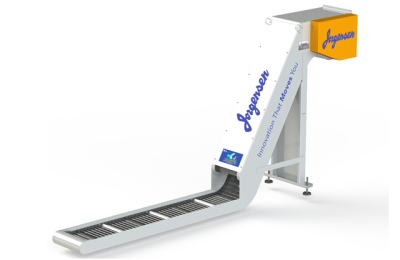
The next-generation MunchMan® Conveyor from Jorgensen Conveyor and Filtration Solutions provides the most-successful system on the market today to manage long, stringy and nested metal chips generated from high-speed turning and milling operations. Jorgensen’s latest system improves on a uniquely effective chip and scrap removal conveyor for the machine tool industry, with a patent-pending design that efficiently and cost-effectively eliminates expensive machine downtime. The unique design of the MunchMan® enables the conveyor to fit most of today’s CNC lathes and machining centers, with little or no additional space required compared to traditional single-belt chip conveyors.
The MunchMan® uses primary and secondary belts installed at the lower curve and through the incline and chip discharge areas of the system. These belts run in unison to grab chips, compress them and carry them securely up steep inclines. This design eliminates the risk of conveyor jams that can occur when chip balls tumble at the lower curve or jam in the conveyor incline section. "Compared to traditional single-belt conveying systems, the physical effect of two moving belts compressing and moving difficult long, stringy chips and larger chip volumes is dramatic," noted Dustin Krueger, Manager of Engineering.
For the ultimate in conveyor controls, the exclusive UVS Ecologic® Conveyor Control with patented Jam ManagerTM functionality enables unattended automatic clearing of minor conveyor jams. On applications that involve cutting oil and coolant, Jorgensen can build MunchMan® with a coolant reservoir. For proper fit, Jorgensen custom fabricates every conveyor to the individual customer’s machine. "We place the highest emphasis on meeting every customer's unique needs with a customized solution," said Karl Kleppek, Director of Sales and Marketing.
Jorgensen customers achieve positive results with the MunchMan® on the production line. One customer reported that “All is well with the MunchMan®. The operator for that machine loves it. We have put it through the wringer and it has performed flawlessly.” Another customer reported "absolutely no breakdowns, and it has spit out large watermelon-sized stringers."
More MunchMan® feedback from Jorgensen customers:
“We’ve never had a Munchman® jam up or cause downtime that was the fault of the conveyor. We currently have 20 in-house and have 6 more on order. When we’ve added MunchMan® onto all our machines, we’ll have more than 50 in total. To say we’re satisfied is an understatement.” – Maintenance Manager, Metro Detroit manufacturer
Contact Details
Related Glossary Terms
- centers
centers
Cone-shaped pins that support a workpiece by one or two ends during machining. The centers fit into holes drilled in the workpiece ends. Centers that turn with the workpiece are called “live” centers; those that do not are called “dead” centers.
- computer numerical control ( CNC)
computer numerical control ( CNC)
Microprocessor-based controller dedicated to a machine tool that permits the creation or modification of parts. Programmed numerical control activates the machine’s servos and spindle drives and controls the various machining operations. See DNC, direct numerical control; NC, numerical control.
- coolant
coolant
Fluid that reduces temperature buildup at the tool/workpiece interface during machining. Normally takes the form of a liquid such as soluble or chemical mixtures (semisynthetic, synthetic) but can be pressurized air or other gas. Because of water’s ability to absorb great quantities of heat, it is widely used as a coolant and vehicle for various cutting compounds, with the water-to-compound ratio varying with the machining task. See cutting fluid; semisynthetic cutting fluid; soluble-oil cutting fluid; synthetic cutting fluid.
- gang cutting ( milling)
gang cutting ( milling)
Machining with several cutters mounted on a single arbor, generally for simultaneous cutting.
- milling
milling
Machining operation in which metal or other material is removed by applying power to a rotating cutter. In vertical milling, the cutting tool is mounted vertically on the spindle. In horizontal milling, the cutting tool is mounted horizontally, either directly on the spindle or on an arbor. Horizontal milling is further broken down into conventional milling, where the cutter rotates opposite the direction of feed, or “up” into the workpiece; and climb milling, where the cutter rotates in the direction of feed, or “down” into the workpiece. Milling operations include plane or surface milling, endmilling, facemilling, angle milling, form milling and profiling.
- turning
turning
Workpiece is held in a chuck, mounted on a face plate or secured between centers and rotated while a cutting tool, normally a single-point tool, is fed into it along its periphery or across its end or face. Takes the form of straight turning (cutting along the periphery of the workpiece); taper turning (creating a taper); step turning (turning different-size diameters on the same work); chamfering (beveling an edge or shoulder); facing (cutting on an end); turning threads (usually external but can be internal); roughing (high-volume metal removal); and finishing (final light cuts). Performed on lathes, turning centers, chucking machines, automatic screw machines and similar machines.

